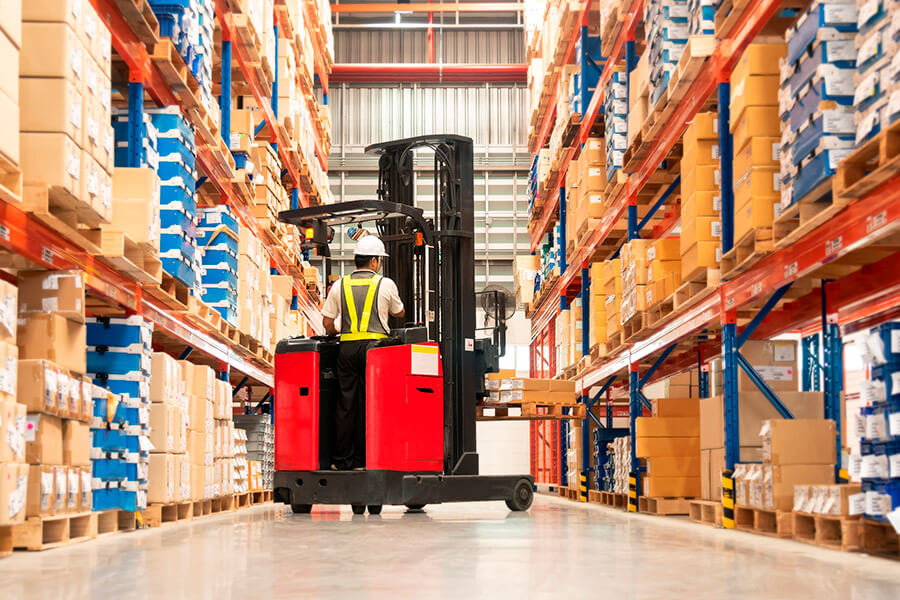Warehouse space is always at a premium. However, it’s a delicate balance between storage area and workplace efficiency. Knowing your forklift clearance dimensions helps ensure you maximize both.
After turning down a warehouse aisle, most forklifts need to make a 90-degree turn, back up, drop off or pick up some cargo, and leave. If you notice a lot of damage to your racking system, you have a problem. Either your aisles are too small, or you are using the wrong machinery, or both.
There is a direct correlation between rack damage, aisle width, and type of forklift. So, unless you want your forklift operators to look like Austin Powers driving a luggage cart every time they load and unload the stacks, you need to know the minimum aisle width for forklift and warehouse safety and efficiency.
The standard aisle width for forklift clearance is between 12 and 14 feet. However, that width may not be appropriate for your needs. For one, that width assumes you’re using a four-wheel counterbalanced forklift as opposed to other types of forklifts, which are designed to navigate narrow aisles (8.5 to 10.5 feet wide, on average) and very narrow aisles (5 to 7 feet wide, on average). The standard forklift aisle width also assumes inventory fits on a standard pallet, and your products may be wider or narrower.
Forklift turn radius
In truth, the forklift turn radius is only part of a valuable formula that helps you determine a warehouse’s minimum aisle width. The formula is relatively straightforward. The most challenging part may be discovering the necessary forklift clearance dimensions. The formula is:
Outer forklift turning radius + load center + load length + 12 inches = minimum aisle width
This calculation provides a rough estimate that can help when considering a new warehouse layout or purchasing a forklift. Before making any (expensive) decisions, always check with your forklift supplier or a qualified material handling company.
Outer forklift turning radius (OTR)
Also referred to as the “basic right-angle stack,” the outer forklift turning radius is the minimum space a forklift needs to turn in an aisle and store a pallet. This number is more than the width of a forklift because the machine needs additional space to swing out for a turn. The outer forklift turning radius (or basic right-angle stack) is listed in the manufacturer’s product manual.
The outer forklift turning radius classification does not consider two crucial factors. The first is that, when a forklift turns in an aisle, it is carrying cargo, and that cargo affects the turn radius. Second, regardless of skill level, every forklift operator requires some wiggle room when turning.
Fortunately, the “minimum aisle width” calculation takes care of those omissions.
Lost load center (LLC)
The “lost load center” is the horizontal distance from the center of the front axle to the front face of the forks. You should be able to find the “lost load center” measurement in the manufacturer’s product manual. Some “minimum aisle width” formulas omit the lost load center. So, if you cannot find this information, is it possible to estimate a “minimum aisle width” without this data.
Load length (LL)
Load length is the size of the pallet plus any product overhang (measured horizontally). Load lengths differ depending on your application, products and more. It is possible, although unlikely, that this information could change for every forklift run. It’s much more likely that you’ll use the standard pallet length, which is 48 inches. However, some industries use 36-inch, 40-inch or 42-inch pallets. So, if you need more clarification, use a tape measure to gauge the size of your pallets.
12 inches
Remember how we mentioned that every forklift operator needs some wiggle room when turning? This is that wiggle room. Adding 12 inches helps ensure there is plenty of forklift clearance and that your aisles remain free from damage and at peak productivity. However, skill levels vary, and operators with less experience may need more than 12 inches of wiggle room.
Minimum aisle width for forklift calculation
The minimum aisle width for a forklift with an outer forklift turning radius of 86 inches, a lost load center of 15 inches, and a load length of 48 inches is 161 inches (which is a little more than 13 feet). To discover this minimum aisle width, simply add:
86 inches (OTR) + 15 inches (LLC) + 48 inches (LL) + 12 inches (buffer) = 161 inches
Narrow aisle forklift turn radius
It is also possible to calculate the turn radius for machines like reach trucks designed to work in narrow aisles. This formula is the same, except it reduces the wiggle room buffer to 9 inches. Please remember that the buffer is intended for trained and skilled operators. It may be safer to stick with the original formula’s 12-inch buffer or more.
A little research and running a few “minimum aisle width for forklift” calculations will help warehouse owners and managers avoid production slowdowns, damage to racking and potentially dangerous accidents.
However, if you notice that your forklifts cannot navigate an aisle because they are not moving, the issue may be with your forklift battery and not your aisle width.
That’s where the professionals at Texas Motive Solutions can help! For all your forklift battery and accessory questions, please reach out to our forklift repair service team at (888) 316-2459. You can also fill out this form to learn about our services and discover everything Texas Motive Solutions can do for you.
Sources
https://www.fork-lift-training.co.uk/buyersguide/forklift-aislway-turning-dimensions.html
https://www.fork-lift-training.co.uk/buyersguide/reach-truck-aisleway-width.html
https://www.toyotaforklift.com/blog/calculating-forklift-aisle-width-minimums#:~:text=Calculating%2012%20inches%20of%20clearance,situations%20resulting%20from%20operator%20error.
https://www.damotech.com/blog/why-aisle-width-matters-when-it-comes-to-pallet-rack-safety



